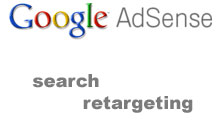Here’s today’s AdExchanger.com news round-up… Want it by email? Sign-up here.
From his Bronte Media blog, Niki Scevak unearths Google search retargeting efforts as Google’s Inside AdSense blog quietly announced last week that a “few hours” of search queries will be used to help target AdSense display ads: “The technical way that we’re doing this is by associating the relevant query words in the referral URL with the existing advertising cookie on the user’s browser. After a short period of time (a few hours) the query words are no longer used for the purposes of matching ads.” Read the AdSense blog. And, read Scevak’s take.
The Display Ad Drumbeat
AdWeek’s Brian Morrrisey pens “Beefing Up Banner Ads” as the display advertising drumbeat grows louder. Quoting ThinkEquity’s Bill Morrison, the benefits of the effective use of ad data is clear: “It’s going to facilitate a lot of brand dollars coming online because they’ll be able to buy audience — and right now it’s really hard for them to do it at scale outside of a few portals.” Read about it.
Lobbying Works
In Mediaweek, Mike Shields takes a look at self-regulation efforts as the Internet Advertising Bureau (IAB) gets kudos from the industry including Tanya Tan at ValueClick who says, “There would have been a bill already if people hadn’t acted.” Read it.
Addressable TV Tests
Yes, addressable media works as a “test involving Comcast Spotlight, the ad-sales unit owned by Comcast Corp., and Starcom MediaVest Group, the media-buying unit of France’s Publicis Groupe, have completed a second test of technology that delivers different ads to different households. The hypertargeting provided a lift of nearly one-third over previous efforts. Read more in Ad Age.
Google And The Local Advertiser
The New York Times’ Miguel Helft looks at Google’s local advertising strategies in “These Battle Lines Are Drawn in Yellow.” In the article, Helft highlights a new system being tested that allows local advertiser to advertise “with a bright yellow tag” on a Google Map or search engine result page, for example, for a flat $25 fee. Read the article.
Looking At The Ad Stack
Brian Tomasette, whose day job is at Ad.com, looks at “The Advertising Stack” on his Mobtownlabs blog. Tomasette thinks it may look like this: “Publisher -> SSP -> Data Segmentation Engine/Provider -> DSP -> Agency -> Advertiser.” He doesn’t stop there as breaks down the essential elements of display advertising, too. Read more.
BlueKai Pulsing Intenders
BlueKai released another edition of its Pulse report that looks at the company’s intender datasets for the time period covering January 2010. Looking at the travel category, “The volume of online flight search actions increased by 45% from December 2009 to January 2010, with activity for domestic destinations up 44% and international destinations up 48%.” Get more Pulse here.
Ad Ops Ringers
AdMonsters President Matt O’Neill gives a nice overview of challenges facing publishers today in a Association of Online Publishers Q&A. As one might expect, O’Neill comes out in favor of a strong ad ops team, “Those publishers who invest heavily in developing the best possible operations teams will come out the winner.” Read more.
The First Follower
Derek Sivers who started seminal e-commerce firm, CD Baby, links to a recording of his TED Talk (the name given to informative presentations at the exclusive TED conference). The centerpiece of the presentation is a video of a random dancer on a hillside who shows that “A leader needs the guts to stand alone and look ridiculous.” But, Sivers says that the first follower of the leader is key. See the dancing -takes only 3 minutes.
Click-Through And Beyond
Lotame’s CMO, Eric Porres rails in AdWeek that “countless RFPs continue to emanate from agencies large and small that cite CTR (click-through rate) as one of — if not the primary — success metric.” Given the lack of importance of the click in display attribution models, Porres argues for change for the sake of brand dollars moving online. Read more.
More On The DSP
Andy Atherton jumps into the DSP discussion with his post on “What Is A DSP?” Preferring a broader definition, Atherton identifies several key characterics of a demand-side platform (DSP) including, “Technology that interfaces directly with demand-side entities.” Read more.











